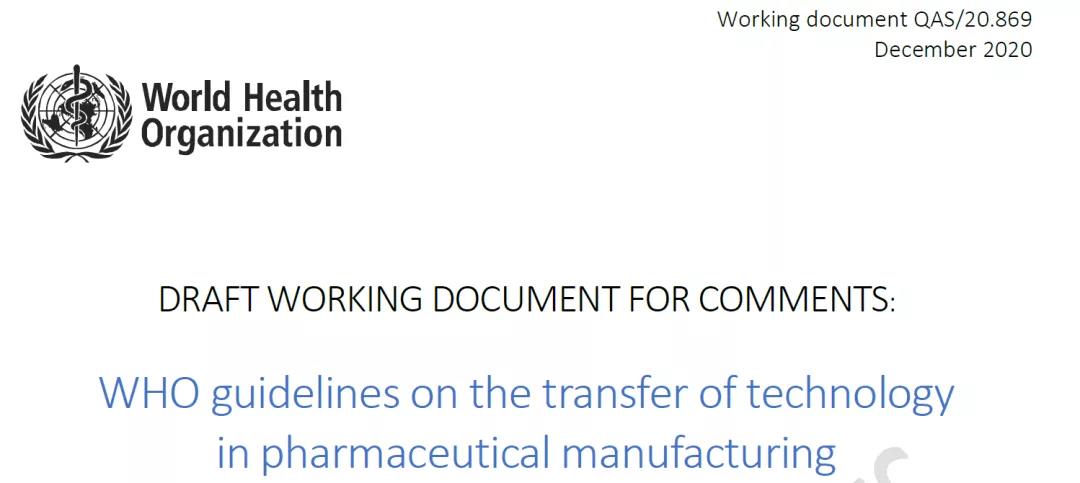扫一扫 添加小助手
服务热线
13818320332
扫一扫 关注我们
 12月4日,世界卫生组织(WHO)于发布《药品生产技术转移指南》(WHO guidelines on the transfer of technology in pharmaceutical manufacturing),提供了药品技术转让期间应考虑的指导原则。
12月4日,世界卫生组织(WHO)于发布《药品生产技术转移指南》(WHO guidelines on the transfer of technology in pharmaceutical manufacturing),提供了药品技术转让期间应考虑的指导原则。
该文件目前正处于收集意见期,截止日期为2021年2月。此后,将于2021年2-3月份提交专家工作组,进行讨论,完善后进行第2轮意见收集。最终修订稿计划于2021年10月份,提交第56药物制剂专家委员会(ECSPP)。

本指南主体部分分为12个章节,内容如下:
背景
1.简介
2.范围
3.术语
4.尽职调查和差距评估
5.组织与管理
6.质量管理和质量风险管理
7.文件
8.设施
9.设备和仪器
10.确认和验证
11.产品生命周期和项目管理原则
12.技术转移项目的阶段
以下是该指南的4-6章内容:
4. 尽职调查和差距评估
Due diligence and gap assessments
4.1. A process of due diligence, gap assessment or audits of the SU and RU should be one of the first steps when considering a technology transfer project.
在考虑技术转移项目时,第一步应该是对SU和RU进行尽职调查/差距评估或审计。
4.2. The suitability and degree of preparedness of the RU should be assessed prior to the start of the transfer. The procedure to be followed should be documented.
转移开始之前,应评估RU的适用性和准备程度。应记录要遵循的程序。
4.3. The assessment should be done by a team of appropriately qualified persons with knowledge and experience in the field of GxP and the activity to be transferred.
评估应由具有适当资质的人员组成的团队进行,这些人员具有GxP和待转移活动领域知识和经验。
4.4. The assessment should further cover resources including personnel, premises, equipment and instruments, utilities, QC, documentation, computerized systems, qualification and validation and waste management.
评估应进一步涵盖资源方面,包括人员、设施、设备和仪器、公用系统、质量控制、文档、计算机系统、确认和验证以及废物管理。
4.5. The assessment to determine feasibility and readiness for technology transfer may include technical, business, regulatory and legal aspects.
确定技术转移的可行性和准备程度的评估可包括技术、业务、法规和法律方面。
5. 组织与管理
Organization and management
5.1. All technology transfer activities should be organized and planned.
所有技术转移活动均应进行组织和计划。
5.2. There should be a formal agreement between the parties which specifies the responsibilities of each party before, during and after transfer. The agreement should cover, for example, data management, data integrity, documentation and validation.
双方之间应该有一个正式协议,规定双方在转移之前、期间和之后的责任。该协议应涵盖例如数据管理、数据完整性、文档和验证。
5.3. All the necessary activities to be executed during the technology transfer project should be identified, organized and documented at the start of the project. Responsibilities should be defined.
在项目开始时,应确定、组织和记录技术转移项目期间要执行的所有必要活动。应确定相关职责。
5.4. The SU should provide the necessary documentation relating to the process, product or procedure to be transferred.
SU应提供与待转移的工艺、产品或程序相关的必要文件。
5.5. The SU should provide criteria and information on inherent risks, hazards and critical steps associated with the process, product or procedure to be transferred. This may serve as a basis for the risk assessment exercise.
就待转移工艺、产品或程序相关的固有风险、危害和关键步骤,SU应提供有关的标准和信息。这可以作为风险评估活动的基础。
5.6. The technology transfer should be managed by responsible persons from the SU and RU. A technology transfer team may be appointed with identified and documented responsibilities.
技术转移应由SU和RU的负责人进行管理。可以任命技术转移团队,该团队具有确定和文件化的职责。
5.7. The team members should have the necessary qualifications and experience to manage the particular aspects of the transfer.
团队成员应具有必要的资质和经验,以管理转移的特定方面。
5.8. The SU should make all the necessary information and knowledge with regard to the product, process or procedure available in relevant documents in order to ensure a successful transfer.
SU应在相关文档中提供有关产品、工艺或程序的所有必要信息和知识,以确保成功转移。
5.9. A training programme should be implemented specific to the process, product or procedure to be transferred.
针对要转移的工艺、产品或程序,应实施培训计划。
5.10. Any changes and adaptations made during the course of the project should be fully documented and agreed to by both parties.
在项目进行工艺中进行的任何变更和调整均应完整记录下来,并征得双方的同意。
5.11. The execution of the technology transfer project should be documented in a report which is supported by the relevant data.
技术转移项目的执行应记录在一份报告中,并有相关数据支持。
5.12 Data should meet ALCOA+ principles.
数据应符合ALCOA +原则。
6. 质量管理和质量风险管理
Quality management and quality risk management
6.1 The SU and RU should each have an appropriately designed, clearly defined and documented quality system.
SU和RU应分别具有适当设计、明确定义和文件化的质量体系。
6.2 The quality system should be adequately resourced, implemented and maintained.
质量体系应有足够的资源,并得到实施和维护。
6.3 The quality system should incorporate GxP which should be applied to the life cycle stages of the products and processes, including the technology transfer.
质量体系应包含GxP,将其应用于产品和工艺的生命周期阶段中,包括技术转移。
6.4 The quality system should ensure that:
• responsibilities are clearly specified in writing;
• operations are clearly defined in writing;
• there is a system for quality risk management; and
• arrangements are made for the documented technology transfer.
质量体系应确保:
•以书面形式明确规定职责;
•以书面形式明确定义操作要求;
•有质量风险管理系统;
•技术转移有文件记录安排。
6.5 Quality risk management should be implemented as a systematic process for the assessment, control, communication and review of risks.
质量风险管理应作为系统性流程来执行,以便评估、控制、沟通和回顾风险。
6.6 The system for quality risk management should be described in writing and cover appropriate areas such as, but not limited to, premises, equipment, materials, products, production, processes, QC, qualification, validation and the process of technology transfer.
质量风险管理系统应以书面形式描述,并涵盖适当的领域,例如但不限于设施、设备、物料、产品、生产、工艺、QC、确认、验证和技术转移流程。
6.7 The evaluation of the risk should be based on scientific knowledge and experience including that of the process and product.
风险评估应基于科学知识和经验,包括工艺和产品方面的知识和经验。
6.8 The level of effort, formality and documentation of the quality risk management process should be commensurate with the level of risk.
质量风险管理过程的工作水平、正式程度和文件记录应与风险水平相称。
6.9 The procedures and records for quality risk management should retained.
质量风险管理的程序和记录应予以保存。
文章来源:PharmLink
本网站刊载的所有内容,包括文字、图片、音频、视频、软件等,如非标注为“原创”,则相关版权归原作者所有,如原作者不愿意在本网站刊登相关内容,请及时通知本站,我们将第一时间予以删除。